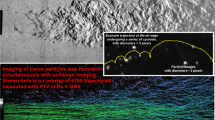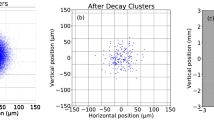Abstract
In molecular tagging velocimetry, patterns of tagged molecules are written in a flow using lasers. They can be lines, crosses or grids. When time proceeds, these patterns are deformed and displaced by the flow. The patterns are followed in time, and from their deformation and displacement, the velocity field can be deduced. In strongly turbulent flow, written lines may be severely deformed or even ruptured, and then, it becomes a challenge to find them in images. We discuss the technique of active contours to trace deformed lines and crosses in turbulence. These patterns can be used to measure the statistical properties of the flow. We illustrate our technique using a variant of molecular tagging in a turbulent flow of air in which NO molecules are formed from N2 and O2 using UV laser beams. A short while later, these patterns are visualized by inducing fluorescence of the NO molecules.







Similar content being viewed by others
References
Bominaar J, Pashtrapanska M, Elenbaas T, Dam N, ter Meulen JJ, van de Water W (2008) Writing in turbulent air. Phys Rev E 77:046–312
Dam NJ, Klein-Douwel RJH, Sijtsema NM, ter Meulen JJ (2001) Nitric oxide flow tagging in unseeded air. Opt Lett 26(1):36–38
Drummond IT (1993) Stretching and bending of line elements in random flows. J Fluid Mech 252:479–498
ElBaz AM, Pitz RW (2012) N2o molecular tagging velocimetry. Appl Phys B 106(4):961–969
Gendrich CP, Koochesfahani MM (1996) A spatial technique for estimating velocity fields using molecular tagging velocimetry (MTV). Exp Fluids 22:67–77
Girimaji SS, Pope SB (1990) Material-element deformation in isotropic turbulence. J Fluid Mech 220:427–458
Girimaji SS, Pope SB (1992) Propagating surfaces in isotropic turbulence. J Fluid Mech 234:247–277
Goto S, Kida S (2002) A multiplicative process of material line stretching by turbulence. J Turb 17:1–12
Gupta SN, Prince JL (1996) Stochastic models for div-curl optical flow methods. IEEE Signal Proc lett 3:32–34
Hill RB, Klewicki JC (1996) Data reduction methods for flow tagging velocity measurements. Exp Fluids 20:142–152
Hsu AG, Srinivasan R, Bowersox RDW, North SW (2009) Two-component molecular tagging velocimetry utilizing NO fluorescence lifetime and NO2 photodissociation techniques in an underexpanded jet flowfield. Appl Opt 48(22):4414–4423
Kass M, Witkin A, Terzopoulos D (1987) Snakes: active contour models. Int J Comput Vis 1:321–331
Koochesfahani MM, Nocera DG (2007) Molecular tagging velocimetry. In: Foss J, Tropea C, Yarin A (eds). Handbook of experimental fluid dynamics, chap 5.4. Springer, Berlin
Michael JB, Edwards MR, Dogariu A, Miles RB (2011) Femtosecond laser electronic excitation tagging for quantitative velocity imaging in air. Appl Opt 50(26):5158–5162
Miles RB, Lempert WR (1997) Quantitative flow visualization in unseeded flows. Ann Rev Fluid Mech 29:285–326
Pumir A, Shraiman BI, Chertkov M (2000) Geometry of lagrangian dispersion in turbulence. Phys Rev Lett 85:5324–5327
Ramsey MC, Pitz RW (2011) Template matching for improved accuracy in molecular tagging velocimetry. Exp Fluids 51(3):811–819
Thurlow EM, Klewicki JC (2000) Experimental study of turbulent Poiseuille–Couette flow. Phys Fluids 12:865–875
Wygnanski I, Fiedler H (1969) Some measurements in the self-preserving jet. J Fluid Mech 38:577–612
Xu C, Prince JL (1998) Snakes, shapes and gradient vector flow. IEEE Trans Img Proc 7:359–369
Acknowledgments
This work is part of the research program of the ‘Stichting voor Fundamenteel Onderzoek der Materie (FOM)’, which is financially supported by the "Nederlandse Organisatie voor Wetenschappelijk Onderzoek (NWO)." The authors are indebted to Margriet Verkuijlen, Thijs Elenbaas and Mira Pashtrapanska for providing data.
Author information
Authors and Affiliations
Corresponding author
Rights and permissions
About this article
Cite this article
van de Water, W., Dam, N. How to find patterns written in turbulent air. Exp Fluids 54, 1574 (2013). https://doi.org/10.1007/s00348-013-1574-7
Received:
Revised:
Accepted:
Published:
DOI: https://doi.org/10.1007/s00348-013-1574-7




